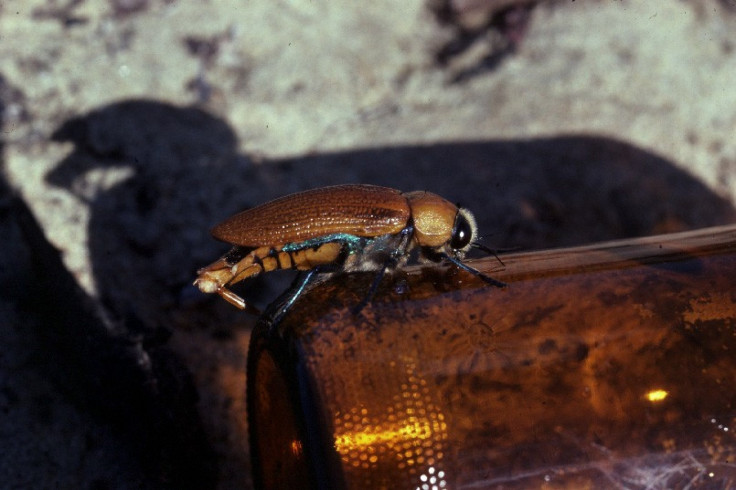Ig Nobel Prize Includes Beetle and Beer Bottle Love Story Turned Tragic

Scientists claimed Ig Nobel Prizes Thursday, including a duo for their research on beetles that mated with beer bottles.
Darryl Gwynne of the University of Toronto and his Australian colleague, David Rentz, claimed the coveted prize- a periodic table on a table- for their 1983 paper Beetles on the Bottle: Male Buprestids Mistake Stubbies for Females.
The paper was published in the journal of the Entomological Society of Australia and in Antenna.
The award was one of several at the 21st First Annual Ig Nobel Prize award ceremony, which took place Thursday evening at Harvard University's Sanders Theater. The Ig Nobels are meant to entertain and to encourage scientific pursuits and come on the eve of the Nobel Prizes to be awarded next week.
Chemistry was the theme of the night, and the Master of Ceremonies was Annals of Improbable Research (AIR) editor Marc Abrahams.
There were several musical numbers throughout the night, as well as a tribute to the late Nobel Stud William Lipscombe. Scientists were honored for their work in topics such as wasabi spray, turtle yawning, and Coca-Cola as a spermicide (note: only regular and diet coke work).
Gwynne and Rentz were tickled to receive their award after so many years. They came to the stage prepared to give Ms. Sweetie Poo candy in case she became bored. She did and they did.
I'm honored, I think, Gwynne said in a statement. The awards make people think, and they're a bit of a laugh. Really, we've been sitting here by the phone for the past 20 plus years waiting for the call. Why did it take them so long?
Gwynne and Rentz were conducting field work in Western Australia when they came upon several beer bottles with male Australian jewel beetles crawling all over them.
There were also beer cans and wine bottles lying around, but these beetles had eyes only for the bottles.
It was clear the beetles were trying to mate with the bottles, Gwynne said.
The beer bottles, known as stubbies in Australian vernacular, resemble super female jewel beetles, Gwynne said. The bottles had an orange and brown color and reflected light in a similar manner to a female jewel beetle.
The male beetles found the stubbies so attractive they ignored the female beetles and attempted to mate with the beer bottles until they were eaten, removed, or died trying.
The researchers noticed another unusual thing about these beer bottles.
Not only do western Australians never dispose of a beer bottle with beer still in it, but many of the bottles had sand and detritus accumulated over many months, they wrote in the paper.
But there is a serious side to the would-be love story turned tragedy.
Improperly disposed of beer bottles not only present a physical and 'visual' hazard in the environment, but also could potentially cause great interference with the mating system of a beetle species, researchers wrote.
This observation prompted Gwynne to send the research results to an Australian brewer.
The research, according to Gwynne, also supports the theory of sexual selection. Males make mating mistakes when they are overly eager.
Only males make mating mistakes, the researchers noted at the Ig Nobel ceremony on Thursday. Not females.
Other award winners included:
-- Arturas Zuokas, the mayor of Vilnius, Lithuania, winner of the Peace Prize for showing that the problem of illegally parked luxury cars can be solved by running them over with an armored tank.
-- John Perry of Stanford University for his Theory of Structured Procrastination, which holds procrastinators can be motivated to do important things as long as they are doing them as a way of avoiding something even more important.
-- Anna Wilkinson of the University of Lincoln in the United Kingdom, Natalie Sebanz of Radboud University Nijmegen in the Netherlands and others for their study that found no evidence of contagious yawning in red-footed turtles.
-- Makoto Imai, Naoki Urushihata, Hideki Tanemura, Yukinobu Tajima, Hideaki Goto, Koichiro Mizoguchi and Junichi Murakami of Japan for determining the ideal density of airborne wasabi -- a pungent horseradish -- to awaken sleeping people and for applying this knowledge to invent a wasabi fire alarm.
-- Karl Halvor Teigen of the University of Oslo, Norway, for trying to understand why, in everyday life, people sigh.
-- Americans Dorothy Martin who predicted the world would end in 1954; Pat Robertson who predicted the world would end in 1982; Elizabeth Clare Prophet who predicted the world would end in 1990; and Harold Camping who predicted the world would end on September 6, 1994, and on October 21, 2011; Lee Jang Rim of Korea who predicted the world would end in 1992; Shoko Asahara of Japan who predicted the world would end in 1997; Credonia Mwerinde of Uganda who predicted the world would end in 1999 -- for teaching the world to be careful when making mathematical assumptions and calculations.
With additional reporting from Reuters
© Copyright IBTimes 2024. All rights reserved.





















